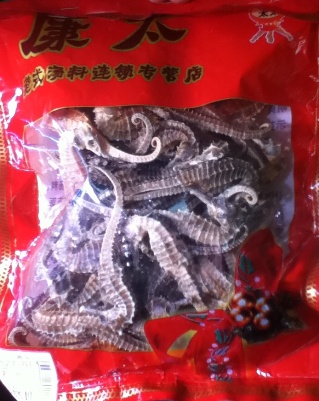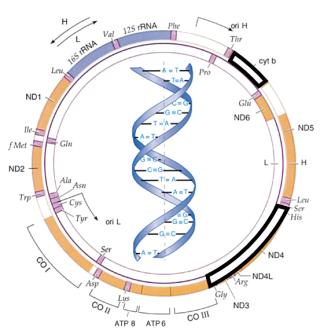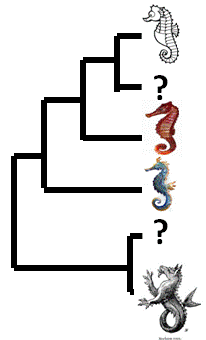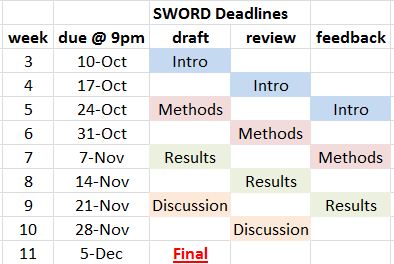Lab Project
Species identification
of seized seahorses
Aim
Most of the molecular labs (as opposed to computer labs) in this class are part of a single project, the species identification of seahorses seized by the US Fish and Wildlife Service. This project has several aims:
- To demonstrate the application of molecular markers to a very practical problem in management and conservation
- To integrate laboratory procedures, lecture materials and literature into a single project
- To provide you with an opportunity to exercise your scientific communication skills by writing a project report.
Background: Seahorse biology and conservation
Seahorses have their name from their horse-shaped heads - their scientific name (Hippocampus) means 'horse monster' in ancient Greek. Together with pipefish, they are members of the Syngnathidae, which are distinguished by fused jaws and an exoskeleton. See also a cool schematic diagram of seahorse evolution by Peter Teske, Rhodes University, SA.
Seahorses live in shallow areas of the tropical and temperate oceans, usually in sea grass beds, mangroves or coral reefs. They are poor swimmers, and therefore need some substrate to hold on to. Their mode of reproduction is unique, with females laying eggs into the pouches of males, which guard eggs and larvae until they emerge as juvenile seahorses.
Because of their coastal habitat and their specialized ecology, seahorses are very susceptible to habitat destruction. Another major threat comes from international trade of seahorses, both live for aquaria and dried as souvenirs and traditional Asian medicine. Little is known about most seahorse species, but the eight species with sufficient data are classified as either endangered or vulnerable by the IUCN, suggesting that the conservation status of the entire group is a cause for concern (see Project Seahorse).
International trade with endangered species is regulated by CITES, and usually requires sufficient knowledge on species biology and the ability to identify species. Unfortunately, seahorses are extremely difficult to identify morphologically, especially when they are dried. As a consequence, CITES restricts the trade of seahorses less than 10 cm long. This restriction protects juveniles of most (but not all) species and so ensures adequate opportunity for reproduction in the wild. In addition, the US Fish and Wildlife Service requires documentation regarding the species and origin of seahorses for importation to the US (see USFWS notice). A nice review paper that provides the most important information on seahorse conservation is Vincent et al. 2011 - you should definitely read that for your report.
The US Fish and Wildlife Service has seized a large number of seahorses from imports from China. We will identify the species of these seahorses, thus obtaining information on the origin of the species, their frequency in the international trade and possible consequences for their conservation.
Our approach is similar to the DNA barcode of life approach, which aims to identify all species by DNA sequences (see also Smith et al. 2008). We will extract DNA from our samples (Fig 1 & 2), amplify and sequence the cytochrome b region of the mitochondrial DNA (Fig 3) and use phylogenetic methods to identify species (Fig 4). In addition, we will attempt to use intraspecific genetic variation to work out the origin of the seahorses. For more information, see the links on the Links page.
Project Report
The results of the project will be written up in a short (no more than 2500 words, excluding references, tables and figures) project report, which should contain all the relevant background, methods, results and discussion. The report should be presented in the format of a scientific paper - here is a file of specific instructions for writing your report .
We will use a 'scaffolding' approach to writing the project report, that is, you will write drafts of specific sections of your report (i.e. Introduction, Methods, Results and Discussion) and receive feedback which you can use for your final project report. These drafts are purposefully a fairly small part of the final grade - nevertheless, take them seriously, because they will help you to get a higher grade on the final report.
Your drafts will be reviewed by four classmates using an online double-blind peer review system (SWORD). This means you will review four other drafts. Double-blind means that both authors and reviewers are anonymous. We set it up this way for three reasons: (i) research has shown that feedback from groups of peers can be more useful for students than instructor feedback. (ii) it can be very helpful to read other peoples' essays to write your own. (iii) this is a good exercise in providing constructive and helpful feedback - something that will be useful in your further career.
Specifically, each of the drafts will have three deadlines, one week apart:
Submission of the draft
There are general and specific (below) instructions for each of the drafts. Make sure to read them before writing. Specific questions for the reviewers, which you can find on Sword, will also help you to write that draft.
Submission of reviews
You will review four drafts each time. Be specific in your reviews. Don't only say 'the writing is unclear', but point out specific examples. It is easier for the author to deal with comments, if you have a numbered list of comments. For example:
- In the first paragraph, the topic sentence needs to be clarified.
- The statement in the second sentence of the third paragraph needs a reference
- Second and third paragraphs are not well linked
- etc
Submission of feedback
A week later, you will submit feedback for the reviews. Your feedback will partially determine the reviewers grade, so be considerate and conscientious. You should provide numerical feedback as well as a specific response to each of the comments. It's fine to disagree with comments, but you need to respond.
At the same time as the feedback, the draft of the next section is due. You should submit your report cumulatively, that is, include previous sections in your submissions. For example, you would submit the results section with the introduction and the methods. In addition, you should start incorporating reviewers' comments when you submit the next section. Incorporation of reviewers comments will be part of the final grade. In addition, if you leave it right to the end, you will have to deal with the final project report and the final exam within a very short time.
Grading of Drafts
Drafts of the project report count for 20% of the class grade. Details of grading can be found in the SWORD student guide. Briefly, for each draft, 20% are task grade (i.e. you get 20% as long as you submit a draft, reviews and feedback). 40% are grade for the draft, which is determined by the assessment by your classmates. The grade from your classmates is curved with a mean of 85% and standard deviation of 10%. This means that it will be very hard to get below a total of 70% on those drafts, even with bad comments of your classmates. Furthermore, reviewers who consistently give a higher or lower grade than others are are weighted less, i.e. your grade is more affected by 'good' graders than 'bad' graders. The final 40% of the grade are for your reviews. Half of that is based on how much you deviate from the other three reviewers of that paper, and the other half on feedback by the author of the draft (i.e. the usefulness of your comments). Note that if you don't submit a draft, you will not be able to review other drafts and provide feedback - you therefore won't get any points for that draft (draft, review and back evaluation). Furthermore, the final grade will be modified based on your response to reviewers and incorporation of their comments.
Final Report
At the end of the quarter, you will submit the final project report online, and it will be graded by one or two of the instructors. We will also check again how much you incorporated useful comments by your reviewers. There will be a lot of work at the end of quarter, so make sure to keep up with the report, and incorporate suggestions early in the quarter.
Sword
On the technical side, SWORD is a very userfriendly program. You will need to set up a student account with SWoRD, which you can do here. Once you have an account, look for the course 'FISH/BIOL 340 AU12'. You will need a password, which is the same as the one for restricted material on this site. If there are any problems with signing up, let me know as soon as possible.
In addition, there are a few files you should look at (links also on the SWORD website):
- Detailed instructions for students how to create an account, log on, submit your drafts and submit review comments.
- A page of student FAQ
- An online tutorial about providing feedback to authors. Please watch it and apply it to your comments.
- I wrote, and will write, detailed instructions for authors and reviewers, which you can see on the SWoRD website when you submit. They are also posted below. However, also have a look at general instructions on how to write a scientific paper.
Note that the deadlines on SWoRD are midnight eastern standard time on the respective Wednesday (Figure 6). This means that deadlines are at 9pm Seattle time. These deadlines are absolute and to the second and not even I can change them. Work submitted up to two days after the deadline will incur a 10% penalty, after that, you cannot submit anymore, and you won't receive a grade.
Specific Instructions
Introduction
Methods; Example paper
Results
Discussion
A Note on Plagiarism
Peer review is a very good tool for learning about writing, but it may have some unintended side effects. You might find it difficult not to copy your peers’ ideas. It's fine to learn from their work - for example, if you see a particularly well structured essay, it's fine to use a similar approach. However, avoid copying phrases and sentences and don’t use the same references without reading them first. Use the following tutorial on plagiarism (here is also an amusing video) to help you produce your own independent writing. Note, too, that you cannot cite the paper you review, because the author is anonymous.
Two points you should be aware of:
1. We use software that compares drafts with final versions, and final versions with each other. Each paper has only four reviewers, so it will be straightforward to detect instances of plagiarism. Any offenses will be dealt with following University policies.
2. The final report will not be graded on a curve. If somebody copies from you, your grade won't be affected.
|

Fig 1: Our seahorse samples in a bag

Fig 2: Dried seahorses to be identified

Fig 3: Schematic of the mitochindrial DNA. We will sequence the cytochrome b region (the shorter of the two white boxes).

Fig. 4: DNA sequence, similar to the one we will obtain from our seahorses

Fig 5: With the sequences, we will reconstruct species phylogenies, which will allow us to identify seahorses to species.

Fig 6: Timetable for submission of drafts to SWoRD - see also dates at the bottom of this page |







